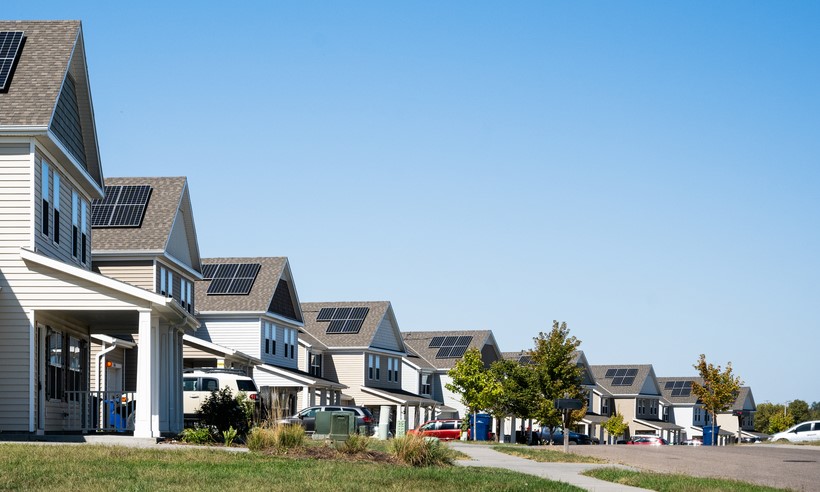As climate change continues to pose significant threats, the U.S. Army is taking bold steps to enhance energy independence and resilience across its installations. At Corvias, we are proud to partner with the U.S. Army to drive this transformation through innovative energy projects. Let’s explore the top energy trends military installations face, and how we are leading the way in implementing these sustainable solutions.
Improving Energy Efficiency
Energy efficiency remains a top priority for the military, driven by the need to reduce operational costs and enhance environmental sustainability. With the U.S. Army's increasing focus on climate strategy goals, centered around readiness and resiliency, energy management becomes even more paramount.
Energy-efficient measures not only lower utility bills but also minimize carbon emissions and contribute to broader sustainability goals. Moreover, energy resilience is crucial for maintaining housing during emergencies or grid disruptions.
Improving Resilience with Long Duration Energy Storage

In the pursuit of energy independence, advancements in energy storage technologies, such as batteries and pumped hydroelectric storage, are revolutionizing energy management. These systems store excess energy generated from renewables at off-peak hours while providing available stable energy during peak demand periods. By generating and storing this energy on-site, U.S. Army bases can mitigate risks associated with supply disruptions and natural disasters, helping ensure a reliable and secure energy supply for mission-critical operations.
At Fort Riley, Corvias is partnering with GM Defense, with the support of a grant from the Department of Energy, to build and implement a Long Duration Energy Storage (LDES) system. This LDES system will optimize energy usage and enhance community resilience across the base. The project includes residential and commercial industrial batteries, and multiple electric vehicles (EV) that can be charged and used as distributed energy resources, providing power around the base as needed. In total, the project will supply 4 Megawatts (MW) of battery storage to the base, which will reduce energy demand from 3rd party utilities.
Renewable Energy for Sustainable Power

Utilizing renewable energy sources on-base is an important step in achieving energy independence. One prominent energy topic gaining traction is the integration of renewable energy sources into existing infrastructure. With growing concerns about climate change and the need to transition to cleaner energy sources, renewable energy adoption has surged across various sectors.
Deploying renewable energy systems offers numerous benefits, including long-term cost savings, energy independence, and environmental stewardship. From solar and wind to hydroelectric and geothermal, renewable energy offers a cleaner, more sustainable alternative to traditional fossil fuels.
At Fort Johnson, Corvias is set to install a solar photovoltaic (PV) system that will provide 13 MW of energy to the base. Once complete, carbon pollution-free electricity (CFE) will supply approximately 40% of the on-base housing’s electrical consumption. The installation will be complete by summer 2025.
Advancing Clean Transport with Electric Vehicles
Globally there is a push toward clean transportation. Electric vehicles produce zero emissions, which reduces greenhouse gas emissions and air pollution around military bases and communities. By transitioning to electric transportation, the U.S. Army can help mitigate climate change, improve air quality and protect public health. Additionally, electric vehicle fleets can serve as distributed energy resources, providing demand response, frequency regulation and energy storage.
Our property management team is piloting electric maintenance vehicles at multiple installations and working with the U.S. Army to establish the infrastructure for electric vehicle charging stations for service members and their families throughout military housing communities.
Improving Home Efficiency
 To further support our sustainability goals, energy efficiency upgrades are crucial in reducing energy consumption and minimizing waste. From smart building technologies and energy-efficient appliances to lighting retrofits and building envelope improvements, we employ varied strategies to enhance energy efficiency.
To further support our sustainability goals, energy efficiency upgrades are crucial in reducing energy consumption and minimizing waste. From smart building technologies and energy-efficient appliances to lighting retrofits and building envelope improvements, we employ varied strategies to enhance energy efficiency.
Moreover, energy efficiency upgrades enhance residents’ comfort, support sustainable practices and contribute to meeting climate objectives. Smart meters, sensors and automated systems enable real-time monitoring of energy usage, identification of inefficiencies and optimization of energy consumption patterns.
Advancing Innovative Technologies
The U.S. Army's commitment to climate resiliency not only enhances base readiness, security and cost savings; it also has broader impacts on our communities. Investing in energy upgrades promotes technological innovation and advances the renewable energy sector. By piloting and deploying new energy systems, military bases can drive research, development and the commercialization of innovative technologies, contributing to economic growth and leadership in the clean energy transition.
Aligning with the Army’s Climate Strategy Goals
By investing in renewable energy infrastructure and implementing energy efficiency measures, we play a critical role in enhancing the resilience of U.S. Army installations. Our unique approach supports the Army’s commitment to reducing greenhouse gas emissions and mitigating climate-related risks, safeguarding mission readiness and environmental sustainability.
The evolving energy landscape presents both challenges and opportunities for stakeholders across industries. We remain dedicated to navigating these changes and delivering tailored energy solutions that meet the needs of our partners and contribute to a more sustainable future. Through partnership, innovation and a steadfast commitment to sustainability, we aim to pave the way for a brighter, more resilient future.
